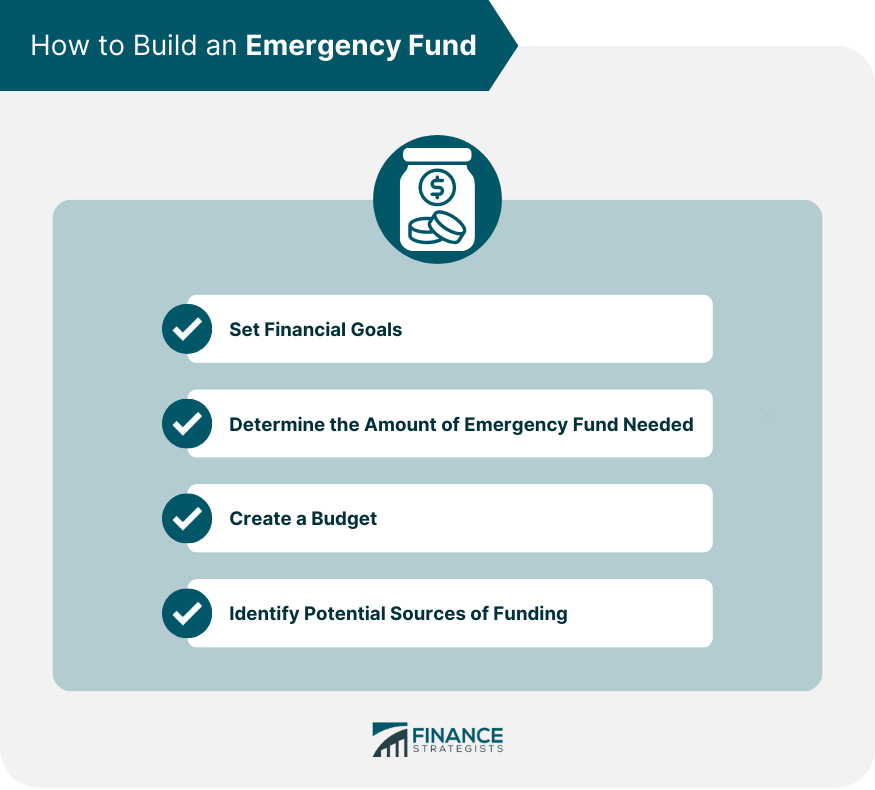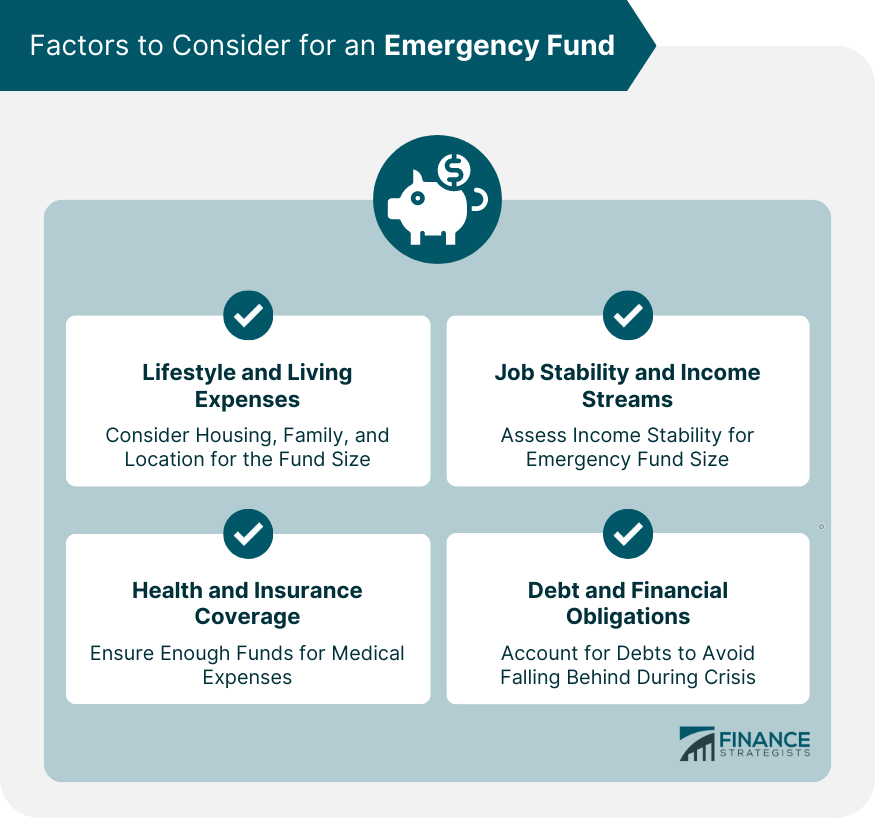An emergency fund is a financial safety net that consists of readily accessible funds set aside to cover unexpected expenses or emergencies, such as medical bills, car repairs, or job loss. An emergency fund is a sum of money set aside specifically to cover unexpected expenses or financial emergencies, such as medical bills, job loss, or unexpected car repairs. The purpose of an emergency fund is to provide a financial safety net and prevent individuals from going into debt or experiencing financial hardship due to unforeseen circumstances. Having an emergency fund is essential for maintaining financial stability and peace of mind. It helps individuals avoid relying on high-interest debt, such as credit cards or personal loans, in times of financial distress. An emergency fund is a critical part of any financial plan, as it provides a safety net in case of unexpected expenses or income loss. Building an emergency fund can seem daunting, but with a solid strategy, it's achievable for anyone. The first step in building an emergency fund is to set specific financial goals. Determine how much you want to save and within what timeframe. Having a clear objective will help guide your savings strategy and keep you focused on achieving your goal. Financial experts recommend having an emergency fund that covers three to six months of living expenses. To determine the amount you need, calculate your monthly expenses, including housing, food, transportation, and other essentials, and multiply that by the desired number of months for your fund. Keep in mind that your fund should also cover any potential healthcare or other unexpected costs. Creating a budget that includes regular contributions to your emergency fund is key to building a healthy savings account. Look for ways to cut discretionary spending and increase your income to free up funds for your emergency fund. For example, you could reduce dining out or entertainment expenses, sell unused items, or take on a side job. Identifying potential sources of funding for your emergency fund can help you reach your goal faster. Consider allocating a portion of your paycheck to your emergency fund each pay period, using tax refunds to boost your savings, or selling unused items around your home. Be creative in finding ways to save money and add to your emergency fund. Consider your lifestyle and living expenses when determining the size of your emergency fund. Factors such as housing costs, family size, and geographical location can impact your financial needs during an emergency. Assess your job stability and income streams when building your emergency fund. If your income is irregular or you have concerns about job security, consider saving a larger amount to cover potential income gaps. Evaluate your health and insurance coverage when planning your emergency fund. Ensure that you have sufficient funds to cover deductibles, copayments, and other out-of-pocket medical expenses in case of illness or injury. Account for any outstanding debts or financial obligations when determining the size of your emergency fund. Having an emergency fund can help you avoid falling behind on payments during a financial crisis. Regularly monitor and reassess your emergency fund, making adjustments as needed to account for changes in your financial situation, expenses, or goals. To maintain your emergency fund, continue focusing on maximizing savings and minimizing expenses. Look for opportunities to save on recurring expenses, such as utilities or insurance premiums, and prioritize debt repayment. Keep your emergency fund in an accessible and secure account, such as a high-yield savings account or money market account. This will ensure that your funds are available when needed while also earning interest. While not ideal, personal loans and credit cards can be used as temporary alternatives to an emergency fund in case of urgent financial needs. However, be aware of high interest rates and the potential for increased debt. A home equity line of credit (HELOC) can provide an alternative source of emergency funds for homeowners. However, using your home as collateral carries risks, and HELOCs often have variable interest rates. In extreme situations, you may consider tapping into your retirement savings accounts, such as a 401(k) or IRA, to cover emergency expenses. However, this should be a last resort, as withdrawing from these accounts can result in taxes, penalties, and long-term consequences for your retirement savings. Building an emergency fund is an essential part of maintaining financial stability and security. To achieve this, it's important to set specific financial goals, determine the amount of emergency funds needed, create a budget, and identify potential sources of funding. Factors such as lifestyle, job stability, health and insurance coverage, and debt should be considered when building an emergency fund. Best practices for maintaining an emergency fund include regularly monitoring and reassessing the fund, maximizing savings and minimizing expenses, and keeping funds accessible and secure. While alternatives to an emergency fund, such as personal loans, credit cards, HELOCs, and retirement savings accounts, exist, these should be used as a last resort due to potential risks and consequences. By following these tips, individuals can create a solid emergency fund plan that provides peace of mind and financial security in times of need.What Is an Emergency Fund?
How to Build an Emergency Fund
Set Financial Goals
Determine the Amount of Emergency Fund Needed
Create a Budget
Identify Potential Sources of Funding

Factors to Consider When Building an Emergency Fund
Lifestyle and Living Expenses
Job Stability and Income Streams
Health and Insurance Coverage
Debt and Financial Obligations

Best Practices for Maintaining an Emergency Fund
Regular Monitoring and Reassessment
Maximizing Savings and Minimizing Expenses
Keeping Funds Accessible and Secure
Alternatives to an Emergency Fund
Personal Loans and Credit Cards
Home Equity Lines of Credit
Retirement Savings Accounts
Conclusion
Emergency Fund FAQs
An emergency fund is a financial cushion that you set aside to cover unexpected expenses, such as medical bills or job loss.
Financial experts generally recommend having three to six months' worth of living expenses saved in an emergency fund.
To build an emergency fund, you can start by setting financial goals, determining the amount needed, budgeting, and identifying potential sources of funding.
When building an emergency fund, you should consider your lifestyle and living expenses, job stability and income streams, health and insurance coverage, and debt and financial obligations.
While credit cards and personal loans can be a temporary solution, relying on them as a long-term emergency fund can lead to high-interest debt and financial stress. It's best to have a dedicated emergency fund.
True Tamplin is a published author, public speaker, CEO of UpDigital, and founder of Finance Strategists.
True is a Certified Educator in Personal Finance (CEPF®), author of The Handy Financial Ratios Guide, a member of the Society for Advancing Business Editing and Writing, contributes to his financial education site, Finance Strategists, and has spoken to various financial communities such as the CFA Institute, as well as university students like his Alma mater, Biola University, where he received a bachelor of science in business and data analytics.
To learn more about True, visit his personal website or view his author profiles on Amazon, Nasdaq and Forbes.











